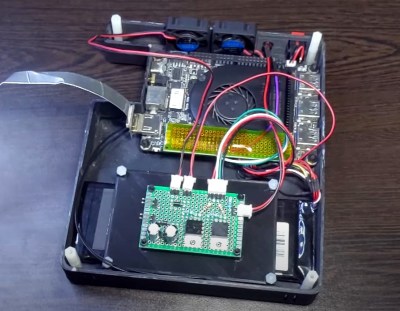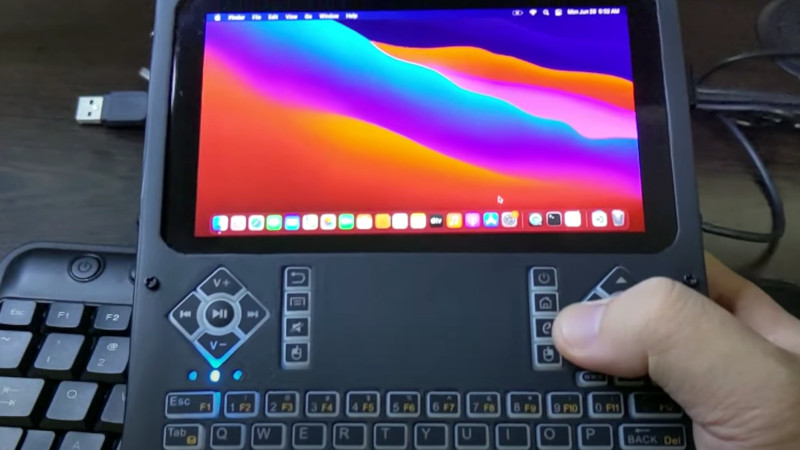We’ve seen a huge influx of bespoke portable computers over the last couple of years thanks to availability of increasingly powerful single-board computers. The vast majority of these have been ARM powered using something like the Raspberry Pi 4, and naturally, run Linux. Only a handful have run on x86 hardware, usually because whoever built it wanted to be able to run Windows.
But this handheld x86 Hackintosh running the latest Mac OS on the LattePanda Alpha is truly something unique. Creator [iketsj] claims it to be a world’s first, and after a bit of searching, we’re inclined to agree. While others have installed Mac OS on the LattePanda to create Hackintosh laptops, this would indeed appear to be the first handheld computer to utilize this particular hardware and software blend.
 Like other custom portables we’be seen, this one starts with a 3D printed enclosure. The overall design reminds us a bit of the YARH.IO we covered last year, and even borrows the trick of reusing the membrane and PCB of one of those miniature keyboard/pointer combos. Which in this case ends up being especially important, as in keeping with Apple’s own portable Mac OS machines, the screen on this handheld doesn’t support touch.
Like other custom portables we’be seen, this one starts with a 3D printed enclosure. The overall design reminds us a bit of the YARH.IO we covered last year, and even borrows the trick of reusing the membrane and PCB of one of those miniature keyboard/pointer combos. Which in this case ends up being especially important, as in keeping with Apple’s own portable Mac OS machines, the screen on this handheld doesn’t support touch.
We especially like how the integrated Arduino on the LattePanda is being used in conjunction with some MOSFETs to control power to the handheld’s LCD, keyboard, and fans. While it sounds like the fans are currently running at full throttle, [iketsj] mentions he does intend on adding automatic speed control in the future. A dedicated “chassis controller” like this makes a lot of sense, and is something we imagine will only become more common as these portable builds become increasingly complex.
Now that we’ve seen a custom portable computer running Mac OS, are we due to see a whole new wave of cyberdecks sporting Cupertino’s software in the future? Maybe not. As [iketsj] points out at the end of this video, Apple’s switch from x86 to their own in-house silicon will almost certainly mean the death of the Hackintosh project within the next few years, bringing a fascinating era of computer hacking to a close.















Very nice aesthetics.
Nice! I had an OQO Model 2 a few years ago, running Hackintosh Mac OS 10.5. It was great, but only lasted for a few months before it somehow managed to die on me (maybe too much current drawn from the USB port on the dock?).
It would be interesting to wire up a Lattepanda to an iPad Mini display, and have a 7-inch Mac that I could use on the bus. I wonder what the battery life is like though, all those fans imply quite high power consumption.
Beautiful build but as time marches on it is a bit sad to be reminded that apple is ” bringing a fascinating era of computer hacking to a close”.
It was a short period anyway, between Apple’s move from PowerPCs to the current shift away from Intel.
“Hackintosh” originally meant taking a Mac board, maybe left over from an upgrade, and putting it in another box.
No, you’re thinking of “HackaDay”.
No, late eighties or early nineties there was an article about doing this in Radio Electronics. There was also a TAB book on the subject, I’d say about 1995.
So there were several people who considered putting something in a container a “hack”? Mkay. Reminds me of the kid in Texas who took apart a clock and put the parts in a box and his teachers said he’d “built a clock”.
My MacBook Pro in my backpack is therefore a Hackintosh.
In the late 80s, people also ran “System” on unsupported computers.
On the Atari ST and Commodore Amiga, for example. Both were 68000 based platforms.
This was possible due to hacks and emulation, I recall.
Before this, Apple itself released “Apple Works”, which ran “System” on the older Apple Lisa computers.
Of course, that’s a bit of a difference from installing Mac OS X on generic Intel PCs.
However, hacking and emulation were *very* popular in the 80s.
It was more popular to the public than in the 90s, maybe.
In the 80s, many computer users had CP/M emulators running or were modifying
existing CP/M systems to run on their hardware (this involved altering the BIOS component of CP/M).
Also, in the 80s and early 90s, there were emulator boards with 68000, Z80 or x86 processors..
These board contained a CPU, the RAM, RTC and maybe one or two interfaces.
The rest was emulated in software.
Couldn’t something be done with current technology ?
Like an Apple M1 processor on a card ? Or an M1 connected via Thunderbolt ?
Some sort of transputer, maybe ?
Sure, it’s not the same as the traditional hackintoshery.
But it would be fun to thinker with, I suppose. :)
They said exactly the same thing about the Franklin Ace.
“bringing a fascinating era of computer hacking to a close.” or opening a new chapter :)
Very nice 👌👍
I really want the part/vendor information for that keyboard. It looks really clean.
Me too.
Looks like an aliexpress bluetooth keyboard. One of the Rii series. Search for Rii i4 mini keyboard and you should be able to find it. Around $15-20 at the moment.
From the video description:
For those who are asking, the keyboard is a Q9 mini wireless keyboard.
Where can we download the 3d files?